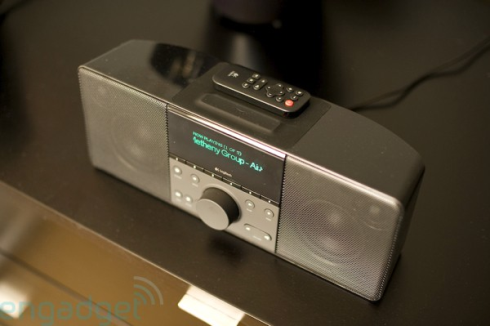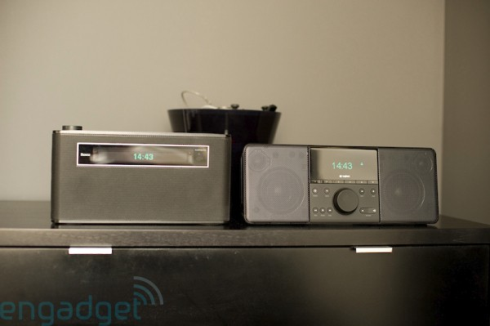
Remember Kerbango? In the early months of the decade, 3Com's foray (via acquisition) into the then-nonexistent world of tabletop internet radios crashed and burned before it was ever even launched, a classic example of an arguably visionary product launching well, well ahead of its time. Over seven years have passed since the Kerbango Radio's untimely death, but for whatever reason, the concept really hasn't re-emerged on a grand scale. On the surface, it seems like a no-brainer: everyone has an alarm clock, many have bedside or kitchen radios, WiFi has since emerged as a ubiquitous cloud of high-speed data, and more people are listening to streamed audio than ever before -- yet the market for these devices is still treated like a niche. What gives?
The perception that the market's still a small one has given rise to a small handful of radios, all of which are pretty rough around the edges. Sales apparently haven't been healthy enough to evolve these devices as briskly as, say, portable players are, so product lifecycles tend to be measured in years, not months. What's more, outside of the odd poorly-marketed, poorly-executed Philips, RCA, or Sony product, major players have continued to steer clear of the market altogether -- not necessarily a bad thing, but little guys like Roku and Tivoli can't light a fire under the tabletop market all by themselves, especially when Tivoli's cheapest model runs $600 (plus another $100 if you're into that newfangled stereophonic sound).
That being said, there have been some notable standouts. Roku's R1000 SoundBridge Radio has been considered a benchmark for the segment since its launch in 2005, thanks to its decent sound quality, decent appearance, a bright, usable display, and an open, non-proprietary philosophy that lets it play nice with just about any music source you can throw its way. Before launching the R1000, Roku cut its teeth on cylinder-shaped players designed to work with an amp or powered speakers, a market it continues to play in today with the venerable M1000.
It's this market -- speakerless players -- where Roku has classically done battle with Slim Devices. Like Roku, Slim has shown a tenacity and an attention to detail in the home media player world that very few manufacturers have, earning it (and its SqueezeCenter media server software) a loyal following. Besides its M1000-fighting Squeezebox, Slim's gone on to show just a little more hustle than Roku has, launching the Transporter for audiophiles and the Sonos-like Duet, slowing down just long enough to get acquired by Logitech somewhere along the way.
Now Slim Devices is circling back to fight Roku once again, this time with the Boom tabletop radio. Realistically, this is a product Slim should've gotten onto the market years ago; it's got a broader appeal than the $2,000 Transporter ever could, and in the meanwhile, Roku's been getting a free lunch out of the deal for its R1000. Never mind that, though; it's here now, so was it worth the wait? And perhaps more importantly, does it out-R1000 the R1000?
Let's address the most important point first: this is an excellent sounding radio. The R1000 was lauded for its sound quality, too, and while the Boom might (emphasis on "might") come just shy of the R1000 for bass response, it's still got a beefy low end and a crisp, full delivery across the range. You won't mistake it for a Transporter connected to $50,000 worth of amps and speakers, but for a diminutive radio chilling on your nightstand, it'll give you more volume than you need (and besides, if you're bleary-eyed enough to be in bed, do you even care how precise the sound is?). Anyone absolutely demanding more bass is in luck, anyway -- the 3.5mm jack on the Boom's backside can be switched between headphone and subwoofer out.

Anyone familiar with Slim's other non-Duet products will feel right at home with the Boom's operation, which is both a good and a bad thing. We would argue that the classic Squeezebox user interface isn't really optimal for a device sitting next to your bed -- or anywhere else you may have it where you'd like to keep control-fiddling to a minimum -- because it's pretty involved. Very few operations involve a single click. Slim does this in the interest of maximum configurability and control (more on this in a moment), but that's little comfort when your trusty radio jolts you out of a peaceful slumber at six in the morning. A perfect example of this "overconfigurability" is the process of setting an alarm: by default, it'll take you no fewer than eleven -- yes, eleven -- clicks and wheel turns to set an alarm if you're starting with a powered-off radio. (Turning off an alarm that's going off, though, is as simple as pressing power or pause, thank goodness.)
Like every other Slim player, the Boom relies very heavily -- almost completely, in fact -- on its network connection to operate. That's a scary thought for a device whose job is getting you up in time for work in the morning. The good news is that the Boom features some internal wizardry that will at least keep the clock going and will preserve just the very next alarm that's scheduled to go off should it lose its connection to SqueezeNetwork or your local SqueezeCenter. After that next alarm, you're on your own. In other words, the Boom is a $300 paperweight without WiFi or an Ethernet cable feeding it bytes, so prepare accordingly.
Initial setup was relatively painless, although the Boom freaked out on us the first time we plugged it in and configure our WiFi connection because we were already running an older version of SqueezeCenter that we later found out is incompatible with the player. SqueezeCenter is Slim Devices' extremely powerful music server software that's capable of streaming and serving your local music library in a number of ways. It's free, it's open source, and it's also used as the nerve center for any Squeezeboxes, Booms, Transporters, or Duets you may have lying around. You go here (through a web interface) to configure how you want your Boom to behave, and the options are dizzying -- sure, you can stick to simple operations like adding favorite playlists and streams, but SqueezeCenter also lets you configure minutae like the number of pixels text jumps when scrolling, how ID3 tags are displayed, and what type of screen saver should be shown when the unit is off. If it doesn't do something you want it to (and trust us, it does a lot), there's a variety of third-party plugins available that can add nifty functionality both to SqueezeCenter and your players.
Of course, the daunting customizability here is a double-edged sword that could easily scare away the non-techie who's just looking for a way to listen to some smooth jazz as he gets dressed in the morning -- never mind the fact that not everyone wants to leave their computer running 24 / 7. That's where SqueezeNetwork comes into play, which is basically Logitech's SqueezeCenter in the cloud; it duplicates most of SqueezeCenter's functionality without the hassle of installing it on your local machine. Granted, you lose access to your local music library, but the proliferation of high-quality streams should be enough to entertain you -- and technically, SqueezeNetwork's integration with MP3tunes could still keep you connected to your own collection if you wanted to go that route.
Physically, the Boom looks and feels great. It's glossy black in all the right places, it's got a high-res VFD display that adjusts brightness automatically based on ambient lighting, and backlit keys and a navigation wheel all done up in soft-touch plastic (we might have liked cloth speaker covers instead of the metal grills, if we're nitpicking). Up top, you'll find a standard-issue snooze button, a must for any serious alarm clock. Smartly, only the power button is lit when the Boom is off -- and don't worry, both the backlight and the VFD get really dim on their lowest setting, so even the most light-sensitive sleepers should be okay. Overall, the button layout's fine, but we would've preferred a knob to a rocker switch to control volume; on a couple occasions, we found ourselves instinctively turning the wheel to juice it when Kenny Loggins' timeless classic Danger Zone started playing, to no avail.

The R1000 (pictured left) requires a remote control to do anything besides change volume, choose a preset, set an alarm, or cycle between AM, FM, internet radio, and the SD slot. By contrast, you can do anything directly on the Boom that you can do with the remote -- yet ironically, it's the Boom that offers a magnetic cradle to stow the remote when not in use (don't ask us where our R1000 remote is). To the R1000's credit, the Boom doesn't offer any terrestrial radio or a built-in SD slot, and we'll admit, an SD slot would've been a nice addition because it's a quick way to play a few tracks that aren't loaded into your master library. AM / FM, though -- well, if that's really a priority for you, there are much cheaper ways to get it just as effectively, and you can't really get great reception on either band without external antennas, anyway.
So is the Boom the tabletop radio to spark a revolution and put an internet-capable device on every nightstand in the world? Realistically, no, it's not -- we're still talking about a pricey, glorified alarm clock here. But does it set a new benchmark in the market? Yeah, absolutely. Roku's R1000 would still be attractive at, say, $200 -- but head to head at $300, the Boom wins for being the better designed, more capable radio.
[Via: Engadget ] [Tag: boom, features, hands on, hands-on, HandsOn, review, slim, slim devices, SlimDevices, squeezebox, squeezebox boom, SqueezeboxBoom ]
0 comments:
Post a Comment